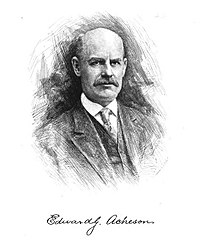Edward Goodrich Acheson
Edward Goodrich Acheson | |
|---|---|
 Edward Goodrich Acheson, from a sketch in The Americana 1911 | |
| Born | March 9, 1856 |
| Died | July 6, 1931 (aged 75) |
| Nationality | American |
| Known for | silicon carbide |
| Awards | John Scott Medal (1894) John Scott Medal (1901) |
Edward Goodrich Acheson (March 9, 1856 – July 6, 1931) was an American chemist.[1] Born in Washington, Pennsylvania, he was the inventor of carborundum,[2] and later a manufacturer of carborundum and graphite. Thomas Edison put him to work on September 12, 1880 at his Menlo Park, New Jersey laboratory under John Kruesi. Acheson experimented on making a conducting carbon that Edison could use in his electric light bulbs.[3]
Biography

Acheson began his career as a surveying assistant for the Pittsburgh Southern Railroad.[4]
In 1884, Acheson left Edison and became supervisor at a plant competing to manufacture electric lamps. He began working on the development of Cubic Zirconium (artificial diamonds) It was here he began his own experiments on methods for producing artificial diamonds in an electric furnace. He heated a mixture of clay and coke in an iron bowl with a carbon arc light and found some shiny, hexagonal crystals (silicon carbide) attached to the carbon electrode.
In 1891 Acheson built an electricity plant in Port Huron at the suggestion of Edison, and used the electricity to experiment with carborundum.
On February 28, 1893, he received a patent on this highly effective abrasive although a 1900 decision gave "priority broadly" to the Electric Smelting and Aluminum Company "for reducing ores and other substances by the incandescent method".[5]
Carborundum is silicon carbide and it is created by electronically fusing clay and carbon. It is the second hardest surface next to diamond.
Throughout Acheson's life, he received 70 patents relating to abrasives, graphite products, reduction of oxides, and refractories.
He died on July 6, 1931, in New York City.
Recognition
In 1997, Acheson was inducted into the National Inventors Hall of Fame.[6] His house in Monongahela, Pennsylvania is a National Historic Landmark.[7]
Notes
- ^ Chambers Biographical Dictionary, ISBN 0-550-18022-2, page 6
- ^ Edward Goodrich Acheson – Carborundum
- ^ "Edward Goodrich Acheson". Chemical Heritage Foundation. Retrieved 2008-10-22.
Edward G. Acheson (1856–1931) was raised in the coal fields of southwestern Pennsylvania. He left school at the age of 16 to help support his family after his father died, but devoted his evenings to scientific pursuits—primarily electrical experiments. In 1880 he had the temerity to attempt to sell a battery of his own invention to Thomas Edison and wound up working for Edison at Menlo Park. After a year he was sent to Europe to install electrical lighting systems in the Hotel de Ville in Antwerp and La Scala in Milan, among other public places.
- ^ "Dr. Acheson Dies; Eminent Scientist, Discoverer of Carborumdum". New York Times. 7 July 1931. Retrieved 3 March 2009.
- ^ Mabery, Charles F. (1900). "Notes, On Carborundum". Journal of the American Chemical Society. XXII (Part II). Johnson Reprint Company, via Google Books scan of Harvard University copy: 706–707. Retrieved 2007-10-28.
- ^ National Inventors Hall of Fame
- ^ "Edward G. Acheson House". National Historic Landmark summary listing. National Park Service. Retrieved 2009-10-01.
